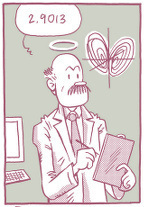Tom Stafford's Blog, page 45
October 28, 2013
A universal difference
 The author of Crazy Like Us, Ethan Watters, has written an excellent article on whether there’s such a thing as ‘human nature’ for the latest edition of Adbusters.
The author of Crazy Like Us, Ethan Watters, has written an excellent article on whether there’s such a thing as ‘human nature’ for the latest edition of Adbusters.
The piece tackles how scientific assumptions about the ‘universals’ of the human mind are having to be revised and discusses research which has shown how people from across the world behave markedly differently in supposedly culturally neutral tasks.
The last generation or two of undergraduates have largely been taught by a cohort of social scientists busily doing penance for the racism and Eurocentrism of their predecessors, albeit in different ways. Many anthropologists took to the navel gazing of postmodernism and swore off attempts at rationality and science, which were disparaged as weapons of cultural imperialism.
Economists and psychologists skirted the issue with the convenient assumption that their job was to study the human mind stripped of culture. The human brain is genetically comparable around the globe, it was agreed, so human hardwiring for much behavior, perception, and cognition should be similarly universal. No need, in that case, to look beyond the convenient population of undergraduates for test subjects…
Henrich’s work with the ultimatum game emerged from a small but growing counter trend in the social sciences, one in which researchers look straight at the question of how deeply culture shapes human cognition.
The article is an engaging look at this new wave of research.
Link to Is There Such a Thing as “Human Nature”?


October 27, 2013
Lou Reed has left the building
 Chronicler of the wild side, Lou Reed, has died. Reed was particularly notable for students of human nature for his descriptions of drugs, madness and his own experience of psychiatry.
Chronicler of the wild side, Lou Reed, has died. Reed was particularly notable for students of human nature for his descriptions of drugs, madness and his own experience of psychiatry.
We’ve touched on his outrageous performance to the New York Society for Clinical Psychiatry before and his songs about or featuring drug use are legendary.
But there was one song that was particularly notable – not least for describing from his own experience of being ‘treated’ for homosexuality with electroshock therapy when he was a teenager.
Kill Your Sons, released in 1974 (audio), is just a straight-out attack on the psychiatrists that treated him:
All your two-bit psychiatrists
are giving you electroshock
They said, they’d let you live at home with mom and dad
instead of mental hospitals
But every time you tried to read a book
you couldn’t get to page 17
‘Cause you forgot where you were
so you couldn’t even read
Here Reed describes the effects on memory that are common just after electroconvulsive therapy. In this case, forgetting what you’ve just read.
The last verse also describes some of his other contacts with psychiatry, mentioning specific psychiatric clinics and medications:
Creedmore treated me very good
but Paine Whitney was even better
And when I flipped out on PHC
I was so sad, I didn’t even get a letter
All of the drugs, that we took
it really was lots of fun
But when they shoot you up with Thorazine on crystal smoke
you choke like a son of a gun
The last line seems to refer to the effect of being given a dopamine-inhibiting antipsychotic when you’re on a dopamine boosting amphetamine – presumably after being taken to a psychiatric clinic while still high. Not a pleasant comedown I would imagine.
I have no idea what ‘PHC’ refers to, though. I’m guessing it’s a psychiatric treatment from the 60s.
It’s interesting that the song was released the year after homosexuality was removed from the DSM in 1973, although it’s never been clear whether this was intentional on Reed’s part or not.
Link to YouTube audio of Kill Your Sons.


The grass is always greener
 If you’re a neuroscience fan, Marketing magazine has a somewhat depressing report of a Susan Greenfield speech to the travel industry at the ABTA conference in Croatia.
If you’re a neuroscience fan, Marketing magazine has a somewhat depressing report of a Susan Greenfield speech to the travel industry at the ABTA conference in Croatia.
It’s sad for two reasons. Firstly The Baroness is still pursuing the same bizarre and evidence-free line that the internet causes all sorts of brain curdling problems and even doubles down on her odd claim that there’s a link with autism:
“People who are not good at interpersonal skills anyway are on the autistic spectrum disorder, they spend a lot of time in the cyber world. Sadly there are a lot of links between this disorder and compulsive video game use.”
She also says some very strange things about the effects of video games and what gamers are like:
They will have a higher IQ because we know that video game rehearsal repeats all the mental agility that is required of IQ tests. However, being good at mental processing without being able to make connections or understand context doesn’t mean to say that you understand about Syria or the economic problems of the world.
Playing video games means you don’t understand the complex situation in the Middle East? An outrageous claim. Has she never played Call of Duty 4?
However, it’s also a little sad because she’s now doing presumably paid talks to travel conferences to say that while technology damages the brain, travel is good for it.
Greenfield was genuinely one of my scientific heroes and motivated me to get into neuroscience through her talks. And now, it’s all gone a bit Donkey Kong.
Link to The Baroness on the cyberapocalypse / holiday cure.


2013-10-25 Spike activity
Quick links from the past week in mind and brain news:

Excellent Nature article on the real impressive science behind the ‘fMRI mind reading’ studies that hit the headlines in unhelpful ways.
The I Have a Therapist campaign aims to destigmatise seeing a therapist.
IEEE Spectrum magazine has a piece on the next world’s strongest fMRI scanner – 11.8 Teslas.
The New York Times has a piece on how the US Military’s DARPA research agency are funding deep brain stimulation research to the tune of $70 million dollars.
A DIY low-cost, open-source kit from BITalino for measuring physiological signals – ECG, EMG, GSR and so on.
Interesting neuromarketing twist in Advertising Age: the same ‘brain truth is the real truth’ illusion but turned round to market the product as having a specific effect on the consumer.
Nautilus has an interesting article on how the mathematics behind codebreaking is being applied to neuroscience.
One family’s search to explain a fatal neurological disorder. American Scientist on the fight against hereditary ataxia.
Discover Magazine’s Crux blog has a piece on five sex research pioneers you’ve probable never heard of.
Scans pinpoint the moment anaesthetic puts the brain under. Report by New Scientist.
The excellent and long-running SciCurious neuroscience blog has moved to a new location.


October 20, 2013
A man called Dad
 An eye-opening 2005 paper estimated the number of children who are not the biological offspring of their presumed father.
An eye-opening 2005 paper estimated the number of children who are not the biological offspring of their presumed father.
Looking at studies from around the world, it concluded that the median number of kids who are not the children of the person they call ‘dad’ is 3.7% with studies typically finding a rate of between two and ten percent.
This is presumably due to children being conceived during clandestine affairs. Whether you think that 3.7% is a low or high figure depends on your view of how human relationships work in real life.
If you want more details there’s an excellent post on Gene Expression which discusses the evidence based and the ethical implications for these findings.
For example, if a child needs genetic testing for medical reasons what should the presenting parents get told about incidental discoveries of ‘paternity discrepancy’?
Link to 2005 study on ‘paternity discrepancy’.
Link to excellent Gene Expression post on the same.


October 19, 2013
The death of the chaotic positivity ratio
 A new online publication called Narratively has an excellent story about how a part-time student blew apart a long-standing theory in positive psychology.
A new online publication called Narratively has an excellent story about how a part-time student blew apart a long-standing theory in positive psychology.
The article is the geeky yet compelling tale of how weekend student Nick Brown found something fishy about the ‘critical positivity ratio’ theory that says people flourish when they have between 2.9013 and 11.6346 positive emotions for every negative one.
It’s been a big theory in positive psychology but Brown noticed that it was based on the dodgy application of mathematician Lorenz’s equations from fluid dynamics to human emotions.
He recruited psychology professor Harris Friedman and renowned bunk buster Alan Sokal into the analysis and their critique eventually got the paper partially retracted for being based on very shaky foundations.
It’s a great fun read and also serves as a good backgrounder to positive psychology.
I’ve also noticed that the latest edition of Narratively has loads of great articles on psychology.
Link to Narratively on Nick Brown the death of the positivity ratio.
Link to latest edition of Narratively entitled ‘Pieces of Mind’.


Seeing synaesthetic stars during sex
 A study in Frontiers in Psychology asked people who have emotional synaesthesia – they see colours when they have certain emotions – about what they experience during sex.
A study in Frontiers in Psychology asked people who have emotional synaesthesia – they see colours when they have certain emotions – about what they experience during sex.
There is a particularly lovely table that illustrates these experiences through the different stages of the sexual response cycle:
Appentance phase
“This phase has an orange character”
Excitement phase
“it’s getting more intensive, starting with a few colours at the beginning and getting more and more intense”
Plateau phase
“The greater the excitement becomes the more thoughts are canalized” “The initial fog transforms into a wall”
Orgasmic phase
“In the moment of orgasm the wall bursts… ringlike structures… in bluish-violet tones”
Resolution phase
“The resolution phase varies between pink and yellow”
It’s worth bearing in mind that emotional synaesthesia isn’t the only thing that can turn sex into a slightly unreal experience.
Some people with epilepsy have seizures triggered by orgasm which can affect both males and females.
All cases reported in the medical literature are people who lose consciousness or have observable movements during the seizure, but this is probably because they are the ones most likely to go to the doctor.
People who have simple partial seizures during orgasm – where they just have unusual experiences but don’t lose consciousness – are probably more common than we think but are less likely to be aware they’re having seizures and so just assume it’s normal for them.
Link to study on synaesthesia and sexual experience (via @Neuro_Skeptic)


October 18, 2013
2013-10-18 Spike activity
Quick links from the past week in mind and brain news:

Is America Less Mentally Healthy Than A Chilean Jail? asks Neuroskeptic.
BPS Research Digest had a special series of articles on people with exceptional abilities such as super calculators, super recognisers and super agers.
Social psychologists say war is not inevitable – according to e! Science News. Tell that to the social priming folks.
CNET has an in-depth article on how IBM is making computers more like your brain both with neuromorphic chips and a liquid power supply.
What your cinema seat says about your personality, according to psychologist Hiromi Mizuki and some crappy PR story from Australia’s Daily Telegraph
CBS Seattle: Psychologist loses license after prostitute steals laptop. Probably after reading that shit PR story on cinemas.
Sleep ‘cleans’ the brain of toxins reports BBC News. I knew it couldn’t be trusted.
New Scientist reports that the “belief that I’m dead” Cotard delusion has been weakly linked to an anti-viral medication although it’s baffling as to why.
The neuroscientists behind Obama’s billion-dollar BRAIN Initiative published a paper in Neuron outlining ideas for the project. Summary: ‘Shit. What do we do now?’
The Guardian publishes an in-depth profile of the head of Europe’s billion dollar brain project, Henry Markram. Summary: ‘Brains? I thought this was an IT project?’


October 16, 2013
Scraping the bottom of the biscuit barrel
 As a wonderful demonstration how media outlets will report the ridiculous as long as ‘neuroscience’ is mentioned, I present the ‘Oreos May Be As Addictive As Cocaine’ nonsense.
As a wonderful demonstration how media outlets will report the ridiculous as long as ‘neuroscience’ is mentioned, I present the ‘Oreos May Be As Addictive As Cocaine’ nonsense.
According to Google News, it has so far been reported by 209 media outlets, including some of the world’s biggest publications.
That’s not bad for some non-peer reviewed, non-published research described entirely in a single press release from a Connecticut college and done in rats.
The experiment, described in five lines of the press release, is this:
On one side of a maze, they would give hungry rats Oreos and on the other, they would give them a control – in this case, rice cakes. (“Just like humans, rats don’t seem to get much pleasure out of eating them,” Schroeder said.) Then, they would give the rats the option of spending time on either side of the maze and measure how long they would spend on the side where they were typically fed Oreos…
They compared the results of the Oreo and rice cake test with results from rats that were given an injection of cocaine or morphine, known addictive substances, on one side of the maze and a shot of saline on the other. Professor Schroeder is licensed by the U.S. Drug Enforcement Administration to purchase and use controlled substances for research.
The research showed the rats conditioned with Oreos spent as much time on the “drug” side of the maze as the rats conditioned with cocaine or morphine.
Needless to say, South American drug lords are probably not shutting up shop just yet.
But this is how you make headlines around the world and get your press release reported as a ‘health story’ in the international media.
As we’ve noted before, the ‘as addictive as cocaine’ cliché gets wheeled out on a regular basis even for the most unlikely of activities but this really takes the biscuit (“Bad jokes addictive as cocaine” say British scientist’s readers).
However, the alternative conclusion that ‘Cocaine is no more addictive than Oreos’ seems not to have been as popular. Only Reason magazine opted for this one.
The reason that this sort of press release makes headlines is simply because it agrees with the already established tropes that obesity is a form of ‘addiction’ and is ‘explained’ by some vague mention of the brain and dopamine.
The more easily we agree with something, the less critical thinking we apply.
Link to a more sensible take from Reason magazine.


October 13, 2013
US Military PsyOps video appears online
A US Military PsyOps video has found its way onto the YouTubes and gives a interesting but clunky guide to ’90s psychological operations.
It’s called The Invisible Sword and it’s a bit like watching a cable TV infomercial for psychological warfare complete with cheesy easy listening background music and stilted dialogue.
“It all gets put together when the chips are down somewhere in the world and it gets put together from the top down”. Thanks General.
The video is also a curious bit of history as it discusses operations that bridge over the time when the US military was transitioning from intervention in the Balkans and proxy wars in Latin America to large scale campaigns in the middle east.
It’s a pre-Human Terrain System view of social intervention that was less focused on managing the relatively small-scale social networks that mediated allegiances between the complex militias intertwined in the ‘war on terror’ and more on larger-scale propaganda.
Link to The Invisible Sword on YouTubes (via @psywarorg)


Tom Stafford's Blog
- Tom Stafford's profile
- 13 followers



